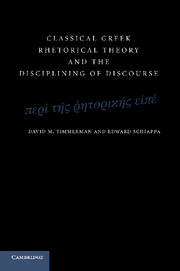Book contents
- Frontmatter
- Contents
- Acknowledgments
- 1 INTRODUCTION: Terms of Art as a Focus in the History of Rhetorical Theory
- 2 DIALEGESTHAI AS A TERM OF ART: Plato and the Disciplining of Dialectic
- 3 PHILOSOPHIA AS A TERM OF ART: Recovering Isocrates
- 4 TERMS OF ART FOR PUBLIC DELIBERATION: Dēmēgoria and Symboulē
- 5 TERMS OF ART AND THE INTERPRETATION OF TEXTS: The Disciplinary Status of the Rhetoric to Alexander
- 6 TERMS OF ART AND INFERRING THEORY: When Did the Parts of a Speech Become Formalized?
- 7 EPILOGUE
- References
- Index
1 - INTRODUCTION: Terms of Art as a Focus in the History of Rhetorical Theory
Published online by Cambridge University Press: 06 July 2010
- Frontmatter
- Contents
- Acknowledgments
- 1 INTRODUCTION: Terms of Art as a Focus in the History of Rhetorical Theory
- 2 DIALEGESTHAI AS A TERM OF ART: Plato and the Disciplining of Dialectic
- 3 PHILOSOPHIA AS A TERM OF ART: Recovering Isocrates
- 4 TERMS OF ART FOR PUBLIC DELIBERATION: Dēmēgoria and Symboulē
- 5 TERMS OF ART AND THE INTERPRETATION OF TEXTS: The Disciplinary Status of the Rhetoric to Alexander
- 6 TERMS OF ART AND INFERRING THEORY: When Did the Parts of a Speech Become Formalized?
- 7 EPILOGUE
- References
- Index
Summary
We contend that the history of Greek rhetorical theory can be enhanced by paying attention to the emergence of terms of art in texts about persuasive speaking and argument. In this introduction, we describe what we mean by “terms of art” and provide a theoretical and historical rationale for our project. We conclude the chapter by explaining the way the subsequent chapters develop this rationale through the examination of specific terms of art.
By “terms of art,” we mean simply any words or phrases that take on reasonably specialized denotative functions within a particular language community. Such terms are typically known in linguistics and philosophy as “kind terms”; not “natural” kind terms denoting physical, chemical, or biological objects, but what Nelson Goodman (1978) calls “relevant” kinds that sort the things of our world into categories in order to meet particular needs and interests. Terms of art can categorize at various levels of scope. They may be as broad as Aristotle's notion of style or expression (lexis), subsets of composition style such as lexis eiromenē and lexis katestrammenē, or terms that describe specific stylistic qualities such as akribeia or precision (O'Sullivan 1992; Halliwell 1993).
As domains of human activity evolve and grow more sophisticated, the vocabulary used by practitioners of these domains becomes more specialized and technical. Regardless of whether explicitly defined by members of a language community, terms of art can be understood as performing a constitutive role within that community that can be formulated as a shared rule: X counts as Y in context C (Schiappa 2003a).
- Type
- Chapter
- Information
- Publisher: Cambridge University PressPrint publication year: 2010



